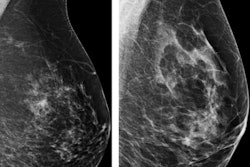
Full-field digital mammography (FFDM) detects breast cancer better than either analog film-screen mammography or computed radiography (CR), regardless of age, breast density, or screening round, according to a South Korean retrospective study of over 8 million women published online on December 3 in Radiology.
Over three years, a research team led by Dr. Seri Hong, PhD, from the National Cancer Control Institute at the National Cancer Center in Goyang, Republic of Korea, examined screening mammograms from the nationwide breast cancer screening program, which was linked with the national cancer registry. They found FFDM performed better than film-screen mammography and CR in screening accuracy and area under the curve (AUC) for the general female population.
"We recommend [FFDM] for the general screening participant, regardless of age or breast tissue density," Hong and colleagues wrote. "Today, considerable use of computed radiography and [film-screen mammography] is found in many countries, although FFDM has substantially replaced [film-screen mammography] in some developed countries such as the U.S. Therefore, universal application requires consideration of the economic aspects of FFDM, within the context of each country's public health environment."
How they compare
A few comparative studies have reported that FFDM is more accurate than analog mammography, but those results were valid only in certain conditions -- namely in women with dense breasts and specific age groups, according to the authors. Also, those studies grouped two different systems -- CR and FFDM -- as a single digital mammography category, despite evidence of different performance levels in the technologies.
"Therefore, it is necessary to reevaluate CR and FFDM separately to achieve more precise test results among the different systems," they added. In addition, most studies involving FFDM were performed in the early 2000s, and the technology, as well as radiologists' adeptness with reading FFDM exams -- has changed since then.
Hong et al examined data acquired from the Korea-wide breast screening program for the period of January 1, 2011 to December 31, 2013. The study included 8,482,803 Korean women ages 40 to 79 who were screened biennially with film-screen mammography, CR, or FFDM. A little more than a third (34.4%) had analog mammography, 51.7% received CR, and 13.9% underwent FFDM.
In total, 13,616 detected breast cancer cases were included. FFDM demonstrated higher sensitivity and AUC but lower specificity, the authors found.
| Performance of different types of screening mammography | |||
| Film-screen mammography | CR | FFDM | |
| Sensitivity | 60.7 | 62.2 | 73.4 |
| Specificity | 89.5 | 89.0 | 87.0 |
| PPV* | 1.3 | 1.4 | 1.8 |
| AUC | 0.75 | 0.76 | 0.8 |
The researchers also discovered the differences between modalities were much larger in the dense breast and young age groups.
| Performance of different types of screening mammography by age and breast density | |||
| Film-screen mammography | CR | FFDM | |
| Extremely dense breasts | |||
| Sensitivity | 52.5 | 53.6 | 62.0 |
| Specificity | 80.7 | 80.3 | 82.4 |
| PPV | 1.0 | 1.0 | 1.6 |
| AUC | 0.67 | 0.67 | 0.72 |
| Women ages 40-44 | |||
| Sensitivity | 49.0 | 54.6 | 65.8 |
| Specificity | 86.0 | 85.3 | 83.2 |
| PPV | 0.8 | 0.9 | 1.2 |
| AUC | 0.67 | 0.70 | 0.74 |
Hong and colleagues found similar AUCs for women ages 45 to 49 (0.70, 0.70, 0.76), which is important given the differences in the guidelines for screening mammography that have been published by the American College of Radiology and the American Cancer Society, they wrote.
These results differ from previous studies because of the time factor -- more than a decade has elapsed since the introduction of the newest equipment -- and FFDM equipment and image quality have improved. Also, it was only recently that researchers distinguished between CR and FFDM, which may have led to underestimated performances of digital mammography systems in previous studies, according to the researchers.
"In this study, we used more recent mammography data and separately assessed the performance indicators of the three modalities," they wrote. "This allowed us to expand the acceptable range and generalize (i.e., without limitations on patient age or breast tissue density) the superiority of the screening accuracy of FFDM when compared with the other two modalities, even though it had a slightly lower specificity."
However, the study has some limitations: It's an observational study involving records of screening exams from three previous years rather than a prospective, randomized trial. That means a potential selection bias could exist regarding the screening modality assigned to each participant, the authors noted.
They urge caution when adopting FFDM because of these considerations and also due to economic factors in each country.



















